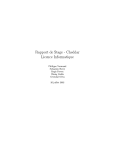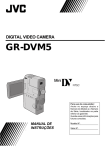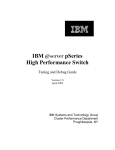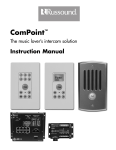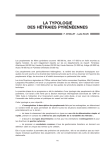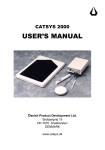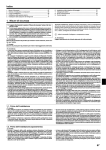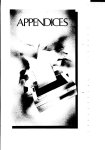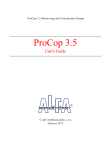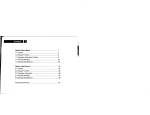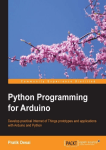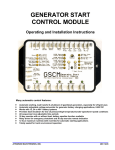Download Guile Programmer`s Manual - Subdude-site
Transcript
Guile Programmer's Manual For use with Cygnus Guile 1.0 Last updated 6 July 1996 Mark Galassi Los Alamos National Laboratory and Cygnus Support [email protected] c 1996 Cygnus Support Copyright Permission is granted to make and distribute verbatim copies of this manual provided the copyright notice and this permission notice are preserved on all copies. Permission is granted to copy and distribute modied versions of this manual under the conditions for verbatim copying, provided that the entire resulting derived work is distributed under the terms of a permission notice identical to this one. Permission is granted to copy and distribute translations of this manual into another language, under the above conditions for modied versions, except that this permission notice may be stated in a translation approved by Free Software Foundation. Chapter 1: What goes in this manual 1 1 What goes in this manual You might be wondering why there are two separate manuals for Guile. It is customary to split the documentation for major packages into a user manual (a gentle and introductory document) and a reference manual. Sometimes people go a step farther and make a separate tutorial; other times the tutorial is part of the user manual. In this framekwork, what you are supposed to do is: use the user manual until you have understood all that it has to oer you, and then use the reference manual for the rest of your life (except when you are teaching). This Guile Programmer's Manual is indeed a reference manual, so I assume that you know everything that's in the Guile User Manual, and you are using this manual to look up the exact detailed specication of what a procedure does, or what a variable means. 1.1 What does NOT go in this manual You will nd that this Programmer's Manual is mostly lled with detailed reference on what each procedure that Guile adds to scheme. More precisely: in a reductionist view, Guile could be viewed as a sum of its parts: guile = PLUS PLUS PLUS PLUS PLUS PLUS PLUS PLUS PLUS PLUS PLUS PLUS standard scheme (R4RS) extensions to R4RS offered by SCM some extra primitives offered by Guile portable scheme library (SLIB) embeddable scheme interpreter library (libguile) Tk toolkit threads Posix library (goonix) OpenGL library (mesa) OpenGL toolkit (glut) Regular expression library (rx) Applet formalism Tcl library So a complete reference on Guile would have to describe the tools given to the programmer by each of these aspects of Guile! Fortunately many of these things have already been documented elsewhere, so we will skip them; some (like Tk) are described elsewhere, but there are language-related subtelties when they are used with Guile, so we document Tk here. We will completely leave out the documentation of standard scheme, SLIB, mesa, glut and Tcl. You can nd many references to this material in section \Where to nd more Guile/scheme resources" in Guile User Manual. There is no bibliography in the Programmer's Manual because the User Manual covers that (see section \Where to nd more Guile/scheme resources" in Guile User Manual). 2 Guile Programmer's Manual 2 Guile Tk reference 2.1 Tk preliminaries Some aspects of the Tk implementation for Guile are not yet in nal form, so I will give you the recipe for using Tk in the guile-r0.3 release. Remember to check this section for changes in new releases of Guile. This chapter is written assuming that you are running the guile program directly. If you are writing a C program instead, and linking with libguile, you can follow the instructions in Chapter 6 [Libguile reference], page 19 to initialize Tk correctly, and then follow this chapter when you write scheme code. The following lines should be at the top of your scheme source le: (require 'Gwish) (use-library tcl) (use-interface tcl) (use-interface tclhack) Your program will then typically create widgets and bind callbacks to the widgets. To then enter the Tk main loop, you need to call: (tk-main-loop) It is important to remember that Tk widget callbacks must always be specied via the special Guile primitive tcl-lambda, rather than the ordinary scheme lambda. This is for two reasons: rst, procedures created by tcl-lambda know that they are still referenced as callbacks, and thus don't get garbage collected away. Second, Guile's Tk implementation is still based on Tcl, and tcl-lambda knows how to convert Tcl calling syntax to scheme. This is expected to change as: (1) Sun works on making Tk independent of Tcl, and (2) the Free Software Foundation makes Guile independent of Tcl. 2.2 Creating widgets The Tk package adds several primitive procedures to scheme; most of these correspond to Tk widget classes, and when invoked they create a new widget. Most of these procedures take the same basic set of options, but then each widget class has its own specic options. Each widget type is described in detail in the very complete Tk man pages, so I will only give a brief description of them here. The User Manual (see section \Creating a widget" in Guile User Manual) got you used to going back and forth between the Tcl/Tk and Guile/Tk calling conventions. The thing to remember here is that pathName arguments are always scheme quoted symbols, and the variables begin with a . (period). Chapter 2: Guile Tk reference 3 button pathName [options ] canvas pathName [options ] checkbutton pathName [options entry pathName [options ] frame pathName [options ] label pathName [options ] listbox pathName [options ] menu pathName [options ] menubutton pathName [options message pathName [options ] listbox pathName [options ] radiobutton pathName [options scale pathName [options ] scrollbar pathName [options ] text pathName [options ] toplevel pathName [options ] update pathName [options ] Tk Widget Creation Tk Widget Creation ] Tk Widget Creation Tk Widget Creation Tk Widget Creation Tk Widget Creation Tk Widget Creation Tk Widget Creation ] Tk Widget Creation Tk Widget Creation Tk Widget Creation ] Tk Widget Creation Tk Widget Creation Tk Widget Creation Tk Widget Creation Tk Widget Creation Tk Widget Creation These procedures create new widgets of the respective type. The options are described in the very detailed man pages for each widget, but also in the special options man page provided by Tk. tk popup menu x y [entries ] Tk Widget Creation Posts a popup menu at location (x, y) on the screen. The menu widget should already have been created. The entry parameter is the index in the menu to which the mouse will point by default. Widgets are destroyed with the destroy procedure: destroy [windows ] Tk Widget Creation Deletes the given windows plus all their descendants. If the root window "." is destroyed, then the entire application will be destroyed. ::: ::: ::: ::: ::: ::: ::: ::: ::: ::: ::: ::: ::: ::: ::: ::: ::: ::: ::: 2.3 Widgets as procedures Once you have created a widget, it automatically becomes a new scheme procedure. This procedure can be invoked with arguments, and such invocation will congure or modify the widget. WIDGET [options ] Tk Widget Conguration Congure WIDGET according to the options. Once again: options are described in detail in the options man page. ::: 2.4 Geometry management procedures The basic procedure used by Tk to arrange widgets on the screen is the packer. To talk to it, use: pack option arg [args ] Tk Geometry Management This geometry manager packas the child windows in order around the edges of the parent. ::: 4 Guile Programmer's Manual Tk is shipped with two other geometry management mechanisms: place, and a way of arranging objects in canvases. place window option value [{option value} Tk Geometry Management place congure window option value [{option value} ] Tk Geometry Management forget window Tk Geometry Management info window Tk Geometry Management slaves window Tk Geometry Management This geometry manager xed placement of windows, where you specify the exact size and location of the master and slave. This is seldom used, since pack is the more common Tk geometry manager. Tk widgets also interact properly with the window manager (as long as you have a good window manager). There is a procedure which allows you to explicitly talk to the window manager: wm option window [args ] Tk Geometry Management Interacts with the window manager, allowing the Tk programmer to set such resources as the title, geometry, resize increments, of that window. There are many possible values for option, documented in the Tk wm man page. ::: ::: ::: ::: 2.5 Event handling procedures Whenever an action happens on the display that might be interesting to the Guile/Tk application (mouse motion, mouse clicks, keyboard events), Tk generates an event. The application can install event handlers to be invoked when these events occur. Many of the event handlers are widget callbacks, which are treated in Section 2.2 [Creating widgets], page 2; here we discuss other procedures that relate to event handling and ow control in Tk. bind widget "<BUTTON-ACTION>" callback Tk Event Handling Binds the given button action to the procedure callback. leevent input-port 'readable [callback] Tk Event Handling leevent output-port 'writeable [callback] Tk Event Handling Creates an event handler for the open le associated with input-port or output-port. The event handler invokes the given callback procedure when the le becomes available for reading (or writing, respectively). focus Tk Event Handling focus window Tk Event Handling focus option [args ] Tk Event Handling Manages the input focus. Without arguments it returns the path name of the focus window. With a single window argument it sets the focus to that window. See the focus man page for a description of the third form. grab [:global] window Tk Event Handling grab option [args ] Tk Event Handling Conne pointer and keyboard events to the subtree of the specied window. The second form has several behaviours according to the value of option, which can be current, release, set, status. ::: ::: Chapter 2: Guile Tk reference 5 tk-main-loop Tk Event Handling Enters the Tk loop, which waits for events and invokes the appropriate callbacks. This is typically called after all widgets have been set up. It never returns until the . window is destroyed. This means that after invoking (tk-main-loop) in a Guile/Tk program, all future computation has to be done in widget callbacks. tkwait variable name Tk Event Handling tkwait visibility name Tk Event Handling tkwait window name Tk Event Handling Wait for a variable to change, or a window to be destroyed. update ['idletasks] Tk Event Handling Process pending events, ush all output, process when-idle handlers, until there are no pending events. If the 'idletasks symbol is passed, only process when-idle handlers. 2.6 Miscellaneous Tk procedures Here are some procedures that come from the Tk module, and which do not belong in the above sections. As usual, complete details are available in the man pages. after ms Tk Misc after ms [commands ] Tk Misc after cancel id Tk Misc after cancel [commands ] Tk Misc after idle [commands ] Tk Misc Exececute the given commands after ms microseconds. bell [display] Tk Misc Rings the bell on the display, or the default display if no display argument is given. bindtags window [tagList] Tk Misc Returns a string describing the bindings associated with the given window. clipboard cmd [args ] Tk Misc Allows manipulation of the Tk clipboard. The cmd argument selects what type of action is taken on the clipboard. This can be clear or append. exit [returnCode] Tk Misc Exits the process. If returnCode is not given it defaults to 0. image option [args ] Tk Misc The image command can create and manipulate images. The option parameter can be create, delete, height, names, type, width. The builtin image types are bitmap (for black and white images) and photo for full-color pixmaps. lower window [belowThis] Tk Misc Without arguments, lower will place the given window under all its siblings in the stacking order. If belowThis is a window pathname, then window will be placed right underneath belowThis. ::: ::: ::: ::: ::: 6 Guile Programmer's Manual option add pattern value [priority] option clear option get window name class option readle leName [priority] Tk Misc Tk Misc Tk Misc Tk Misc Add (or retrieve) window options to (or from) the option database. raise window [aboveThis] Tk Misc Without arguments, raise will place the given window over all its siblings in the stacking order. If aboveThis is a window pathname, then window will be placed right above aboveThis. selection option [args ] Tk Misc Allows manipulation of the X selection. send [options ] app cmd [args ] Tk Misc Arranges for a command cmd to be executed in the application app. tk option [args ] Tk Misc Manipulates internal state variables in Tk. winfo option [args ] Tk Misc Retrieve information about Tk's windows. The option argument species what type of information; it can be 'atom, 'atomname, 'cells, 'children, 'class, 'colormapfull, 'containing, 'depth, 'exists, 'fpixels, 'geometry, 'height, 'id, 'interps, 'ismapped, 'manager, 'name, 'parent, 'pathname, 'pixels, 'pointerx, 'pointerxy, 'pointery and many others listed in the winfo man page. ::: ::: ::: ::: ::: Chapter 3: Goonix reference 7 3 Goonix reference 3.1 Goonix preliminaries Goonix is a posix-compliant (John S. Quarterman and Susanne Willhelm: "UNIX, POSIX, and Open Systems", Addison-Wesley Publishing Co, Inc. 1993) library for systems programming in scheme. It allows the scheme programmer to use the same calls available to C programmers in a posix environment. This chapter is written assuming that you are running the guile program directly. If you are writing a C program instead, and linking with libguile, you can follow the instructions in Chapter 6 [Libguile reference], page 19 to initialize goonix correctly, and then follow this section when you write scheme code. Unlike the Tk package, no special scheme code is required to initialize goonix: all goonix procedures are primitive, and available as long as goonix has been initialized with the correct libguile calls. When documenting the procedures in this chapter, I use the convention [arg] to indicate that the argument is optional, and [args ] to indicate that the optional argument can be repeated. You will notice that most of these procedures closely mirror the equivalent UNIX system or library calls. If you want to know more detail about how these procedures behave, you can read the relevant UNIX man page. You will also notice that many of these procedures begin with a % character. There is a convention in goonix that puts a % in front of all procedures that might invoke the scheme (error ...) mechanism, thus escaping from the current continuation. ::: 3.2 I/O extensions to standard scheme These I/O Extensions to scheme provide many of the UNIX le system calls, thus allowing sophisticated le manipulation and directory traversal. This is mostly done using UNIX's stdio layer, rather than the raw open, read, write layer. Standard I/O le pointers are directly translated to scheme ports. Ports are described in great detail in all the scheme references (see section \Where to nd more Guile/scheme resources" in Guile User Manual), so I will simply remind you that an input port is a scheme object which can deliver characters, and an output port is a scheme object which can accept characters. It is OK to think of ports as le pointers, even though there are some subtelties in ports related to scheme's unique control structure. In the following read/write routines, if port is omitted, standard input (or standard output) is assumed. read-line [port] I/O Extensions Reads a line of text from the given input port, and returns the string. If port is not specied, standard input is assumed. read-line! str [port] I/O Extensions A destructive version of the above: puts the string in str; return value is unspecied. 8 Guile Programmer's Manual write-line obj [port] I/O Extensions Writes a representation of obj to port. If port is not specied, it is assumed to be standard output. %ftell port Returns the current seek pointer of the given port. I/O Extensions %fseek port oset whence I/O Extensions Sets the seek pointer for port to the position oset. If whence is 0, that oset is with respect to the beginning of the le. If whence is 1, the oset is with respect to the current position. If whence is 2, the oset is with respect to the end of the le. %freopen lename modes port I/O Extensions Opens lename with the specied modes, and associates port with that le. %duplicate-port old-port modes Returns a new port having the same open le as old-port. I/O Extensions %redirect-port into-port from-port I/O Extensions Redirects I/O from from-port to into-port: from here on, into-port will refer to the same le as from-port. If into-port already refers to an open le, it will be closed. %opendir dirname I/O Extensions Opens the directory dirname, returning a directory port which can be used with %readdir and closedir. %readdir dirp I/O Extensions rewinddir dirp I/O Extensions %closedir dirp I/O Extensions Gets the next le name from the directory port dirp. Repositions the directory port dirp to the beginning of the stream. Closes the directory port dirp. %mkdir dirname [mode] I/O Extensions Makes a new directory with name dirname. The directory permissions are given by the optional argument mode, or by the current umask if mode is not specied. %rmdir dirname I/O Extensions %chdir path I/O Extensions %getcwd I/O Extensions %chmod lename mode I/O Extensions Removes the directory with path dirname. Changes the current working directory to path. Returns a string with the current working directory. Sets the permission mode on lename to mode. Chapter 3: Goonix reference 9 %utime path [actime [modtime]] I/O Extensions Sets the access and modication times of the le at path. The time values actime and modtime are given in standard UNIX time: the number of seconds since 00:00:00 GMT, Jan. 1 1970. If actime and modtime are not given, the current time is used. umask [mask-value] I/O Extensions Sets the user's umask to be the specied value mask-value. The new setting is returned. If no mask-value is given, umask will return the current setting. Notice that the UNIX umask command interprets the mask-value to be an octal integer, whereas the goonix umask call does not make any such conversion, so you have to explicitly tell scheme to use an octal radix, or think about permissions in decimal! %rename old-fname new-fname I/O Extensions Renames the le from old-fname to new-fname. This is analogous to the UNIX mv command and the rename system call. %leno port I/O Extensions Returns the integer le descriptor associated with port. In case of error, #f is returned. %isatty port I/O Extensions Returns #t if the port is associated with a terminal device, and #f otherwise. %fdopen fd type I/O Extensions Returns an I/O port associated with the numeric le descriptor fd (which is assumed to be already open). The type argument is a standard I/O character string specifying whether the le should be opened for reading, writing, or appending: r open for reading w truncate or create for writing a append: open for writing at end of create for writing r+ open for update (reading and writing) w+ truncate or create for update a+ append; open or create for update at EOF file, or %primitive-move->fdes port fd I/O Extensions Moves the le descriptor that underlies port to the given value fd. Returns #f for error, 0 if the le descriptor is already equal to fd, and 1 if the le descriptor is successfully moved. %access path how I/O Extensions Determines the accessibility of the le in path. The how variable can take on any of the following values: 10 Guile Programmer's Manual R_OK test for read permission W_OK test for write permission X_OK test for execute or search permission The following value may also be supplied for mode: F_OK test whether the directories leading to the file can be searched and the file exists. %stat lename I/O Extensions Gets typical UNIX stat information on lename, and returns that information in a scheme vector, where the UNIX stat structure values are stored in the following order: #(st_dev st_ino st_mode st_nlink st_uid st_gid st_rdev st_size st_ atime st_mtime st_ctime st_blksize st_blocks) getpid I/O Extensions Returns the current process ID. %putenv str I/O Extensions Takes a string str of the form "VARIABLE=value" and adds that to the user's environment. 3.3 Posix system and library calls %chown path owner group Changes the ownership of path to the specied owner and group. %link oldpath newpath Adds newpath as a hard link to oldpath. %pipe POSIX Calls POSIX Calls POSIX Calls Creates a pipe, and returns a scheme pair with the read port in its car and the write port in its cdr. If the pipe creation fails, %pipe returns #f. open-pipe pipe-str mode POSIX Calls Opens a pipe to a new process by running pipe-str, and returns a port which can be used to write to the process (if mode is "w") or read from it (if mode is "r"). open-input-pipe pipe-str POSIX Calls A shortcut for running (open-pipe pipe-str "r"). open-output-pipe pipe-str POSIX Calls A shortcut for running (open-pipe pipe-str "w"). %getgroups POSIX Calls Returns a vector with all the supplementary group IDs of the current user process. Chapter 3: Goonix reference 11 %getpwuid [name] POSIX Calls Given the login-name or uid in name, %getpwuid returns a vector with the following data: #(login-name password uid gid GEGOS home-dir shell). If name is not specied, the rst entry in the password le is returned (or the next entry, upon successive invocations). setpwent [arg] POSIX Calls If called with an argument, setpwent rewinds the password le so the next call to %getpwuid will start from the beginning. Without arguments, setpwent will close the password le; it can be used when processing is complete. %getgrgid [which-group] POSIX Calls If the argument which-group (either the group name or the gid) is given, %getgrgid returns the group le entry for that group. If which-group is not given, the rst entry in the group le is returned (or the next entry, upon successive invocations). setgrent [arg] POSIX Calls This is analogous to setpwent, but for the group le. If called with an argument, setgrent rewinds the group le so the next call to %getgrgid will start from the beginning. Without arguments, setgrent will close the group le; it can be used when processing is complete. %kill pid sig POSIX Calls Sends a signal sig to the process pid. The possible values for sig are the usual UNIX signal types. Notice the order of arguments: this is the order of the UNIX kill system call, not the order of the kill command usually typed at the shell. %waitpid pid [options] POSIX Calls Waits for some or all child processes to exit or return a status. If pid is -1, %waitpid will wait on any of its children. This is equivalent to the traditional UNIX wait system call. If pid is greater than 0, %waitpid will wait on that particular child process. If pid is equal to 0, %waitpid will wait on any children in its own process group. If pid is less than -1, %waitpid will wait on any children in the process group of the particular child abs(pid). The options argument is a bitwise OR of any of the ags: WNOHANG Tells %waitpid to not suspend if status is not immediately available for one of the relevant child processes. WUNTRACED Also reports status of children that are stopped and have not yet been reported. The value returned by %waitpid is a scheme pair of the child pid and the status returned for that child. 12 Guile Programmer's Manual getppid POSIX Calls getuid geteuid getgid getegid POSIX Calls POSIX Calls POSIX Calls POSIX Calls %setuid id %seteuid id %setgid id %setegid id POSIX Calls POSIX Calls POSIX Calls POSIX Calls Returns the process id of the current process's parent. Returns the real or eective user or group id of the current process. Sets the real or eective user or group id of the current process. ttyname port POSIX Calls Returns a string with the path of the terminal device associated with the port, or #f if the device is not a terminal. Notice how this also serves the function of the UNIX isatty() call. %execl command-str [exec-args %execlp command-str [exec-args POSIX Calls POSIX Calls Similar to execl, except that if lename does not contain a slash it searches for the le in the directories listed in the PATH environment variable. %execlp is similar, but returns #f if an error occurs. ::: ] ::: ] %fork POSIX Calls This is a raw interface to the UNIX fork() system call. It creates a new process with the same core image as the current process. %fork returns #f upon failure; otherwise the child gets a return value of 0, and the parent gets the child's pid. See the UNIX fork man page for some of the subtelties of %fork (open le descriptors, directory streams, semaphores, tms values, le locks, ). ::: %select reads writes excepts secs msecs POSIX Calls The %select call is used to examine a set of le descriptors (passed as scheme lists of non-negative integers in readfds, writefds and exceptfds). The purpose of this examination is to determine if the descriptors are ready for the requested operation (reading or writing or treatment of exception). The return value is a list of 3 lists; the three lists are the original lists stripped down to only the ready le descriptors. A timeout can be specied (in seconds plus miliseconds) with the secs and msecs are used. %uname POSIX Calls This is an interface to the UNIX uname() system call. Upon successful completion it returns a list of 5 strings describing the system name and OS version: (list OSname nodename OSrelease OSversion MachineType). Upon failure it returns #f. Chapter 3: Goonix reference environ [env-list] POSIX Calls With no argument, returns the current environment as a scheme list of "VAR=val" strings. It can be called with a list of "VAR=val" strings, and then the environment will be set to those values. 3.4 UNIX system and library calls %mknod path mode dev UNIX Calls Creates a new le named by the string path. The le permissions are specied in mode, and some special le type bits can also be OR-ed in (see the mknod() man page for details on the le type bits). The dev argument is ignored unless mode is a block or character special le, in which case dev is a conguration-dependent specication of a character or block I/O device. %acct path UNIX Calls Turns on or o process accounting. The accounting information will be reported in the le named by the string path. If path is #f, accounting will be turned o. Must be super user to use this call. %nice increment UNIX Calls Changes the nice value of a UNIX process by increment (remember: a large nice value means less priority). Only the super user can set a negative increment. The value of increment should be between -20 and 20; if it is outside these bounds it will be silently adjusted to the extreme value. sync UNIX Calls Schedules a write to disk of all information in core memory that should be on disk, such as super blocks, inodes and buered disk I/O. %symlink oldpath newpath UNIX Calls Makes newpath be a symbolic link to oldpath. %readlink path UNIX Calls Returns a string with the contents of the symlink at path. The contents is the path to the real le. Returs #f on any error condition. %lstat path UNIX Calls Like %stat except that if path is a symlink, %lstat will return information about the symlink, whereas %stat will look at the referenced le. The rationale behind this is that symlinks should be transparent to the traditional UNIX le system calls, but extra calls (like %lstat and %readlink) are provided to get more information. 13 14 Guile Programmer's Manual 4 Guile threads reference Here is a the reference for Guile's threads. In this chapter I simply quote verbatim Tom Lord's description of the low-level primitives written in C (basically an interface to the POSIX threads library) and Anthony Green's description of the higher-level thread procedures written in scheme. When using Guile threads, keep in mind that each guile thread is executed in a new dynamic root. 4.1 Low level thread primitives with-new-thread thunk error-thunk Function Evaluate (thunk) in a new thread, and new dynamic context, returning a new thread object representing the thread. If an error occurs during evaluation, call error-thunk, passing it an error code describing the condition. [Error codes are currently meaningless integers. In the future, real values will be specied.] If this happens, the error-thunk is called outside the scope of the new root { it is called in the same dynamic context in which with-new-thread was evaluated, but not in the callers thread. All the evaluation rules for dynamic roots apply to threads. join-thread thread Function Suspend execution of the calling thread until the target thread terminates, unless the target thread has already terminated. yield Function If one or more threads are waiting to execute, calling yield forces an immediate context switch to one of them. Otherwise, yield has no eect. make-mutex Create a new mutex object. Function lock-mutex mutex Function Lock mutex. If the mutex is already locked, the calling thread blocks until the mutex becomes available. The function returns when the calling thread owns the lock on mutex. unlock-mutex mutex Function Unlocks mutex if the calling thread owns the lock on mutex. Calling unlock-mutex on a mutex not owned by the current thread results in undened behaviour. Once a mutex has been unlocked, one thread blocked on mutex is awakened and grabs the mutex lock. Chapter 4: Guile threads reference 4.2 Higher level thread procedures with-new-thread thunk error-thunk Function Evaluate (thunk) in a new thread, and new dynamic context, returning a new thread object representing the thread. If an error occurs during evaluation, call error-thunk, passing it an error code describing the condition. [Error codes are currently meaningless integers. In the future, real values will be specied.] If this happens, the error-thunk is called outside the scope of the new root { it is called in the same dynamic context in which with-new-thread was evaluated, but not in the callers thread. All the evaluation rules for dynamic roots apply to threads. join-thread thread Function Suspend execution of the calling thread until the target thread terminates, unless the target thread has already terminated. yield Function If one or more threads are waiting to execute, calling yield forces an immediate context switch to one of them. Otherwise, yield has no eect. make-mutex Function Create a new mutex object. lock-mutex mutex Function Lock mutex. If the mutex is already locked, the calling thread blocks until the mutex becomes available. The function returns when the calling thread owns the lock on mutex. unlock-mutex mutex Function Unlocks mutex if the calling thread owns the lock on mutex. Calling unlock-mutex on a mutex not owned by the current thread results in undened behaviour. Once a mutex has been unlocked, one thread blocked on mutex is awakened and grabs the mutex lock. 15 16 Guile Programmer's Manual 5 Guile applet specication This chapter has been written by Gordon Irlam, [email protected], at Cygnus Support, February 28, 1996. It is included here almost verbatim. This section provides the specication for writing Guile applets for use with the SurfIt! demo browser. 5.1 HTML applet extension Guile Scheme applets are denoted by the mime type application/guile. This is the default type for the le extension .scm. An applet can be inlined within a HTML document. <a href="applet.scm" rel=embed> fallback_html </a> The applet applet.scm will be loaded, inserted into the page, and run when the document containing it is rst loaded. fallback html will be displayed by browsers that don't support Guile applets. An applet may also be invoked when a hyperlink is followed. <a href="applet.scm" fallback_html </a> When the hyperlink is selected the applet applet.scm will be loaded and executed. The original document will be cleared from the page only if the applet explicitly requests it to be. fallback html will be displayed by browsers that don't support Guile applets. 5.2 Applet requirements An applet is required to be a syntactically well formed Guile scheme program. When an applet is invoked the corresponding Guile program is retrieved, loaded, and executed. Every applet is required to include the applet library: (require 'applet) Incorporate the applet library into a Guile application. This is needed as a prerequisite to performing any of the other applet commands. Every applet is required to dene a routine to be called by the browser when the browser requires the applet to terminate execution: dene-applet-terminate routine Applet API routine is the name of a routine that will be invoked by the browser when the applet is required to terminate execution. If the applet is visible it should destroy the Tk canvas upon which it is visible and then exit. An applet will persist for as long as it is accessible { either externally through it's being displayed on a page, or internally through the scheme environment. Chapter 5: Guile applet specication 17 5.3 Applet API All applets reside in the same top level environment. This allows state to be shared between applets and to persist between applet invocations. An applet has access to all the features of a regular Guile scheme program and to the gtcl/gtk Guile extensions. The features of gtk allow the Guile applet to interactively display itself within the parent document. Note: While Guile provides the ability to control namespaces, and this is necessary to provide a secure environment within which applets can be run, this has not been done for the SurfIt! Guile demo browser. The SurfIt! Guile demo browser is mainly intended as a research prototype, not a production web browser. browser-window-name Variable browser-window args Applet API browser-window-name is a string containing the Tk window name of the browser window. browser-window is the corresponding Tcl proc to which window commands can be sent. applet-window-name Variable applet-window args Appplet API applet-window-name is a string containing a Tk window name for a frame that can be used to contain the applet. applet-window is the corresponding Tcl proc to which window commands can be sent. The frame still needs inserting into the browser window, assuming the applet is visible. applet-embedindex Variable applet-embedindex is a string containing the oset within the browser window of the applet's anchor. Most commonly this is used when insert the applet into the browser window at the same location as the original html: (browser-window 'window 'create applet-embedindex :window applet-window-name). applet-newpage Applet API This routine clears the current contents of the browser window. applet-parsehtml html Applet API This routine parses the html specied by html and renders the result adding it to bottom of the browser window. applet-loadurl url Applet API This routine loads and renders the contents of the object specied by URL url inserting it into the applet window. applet-loaddata url Applet API This routine loads and returns the contents of the object specied by URL url. Note: This particular routine will probably not be present in guile-r0. Its suggested incorporation into the API, and it's syntax are still tentative. 18 Guile Programmer's Manual 5.4 Applet behavior Applets should not monopolize the cpu. Instead they should be written using a callback or event loop polling based style so that the Tk event handler can continues to operate, and the user can continue to interact with the browser. 5.5 Browser behavior Any run time error occurring within an applet that goes uncaught will cause the applet to exit, but the browser will continue to function. Chapter 6: Libguile reference 19 6 Libguile reference The Guile interpreter is essentially Aubrey Jaer's SCM interpreter (see section \Overview" in SCM: a portable scheme interpreter) with some modications to make it suitable as an embedded interpreter. Part of the modication has been to provide a restricted interface to limit access to the SCM internals; this is called the gscm_ interface, or libguile interface. If you are programming with Guile, you should only use the C subroutines described in this manual, which all begin with gscm_. If instead you are extending Guile, you have the entire SCM source to play with. This manual will not help you at all, but you can consult Aubrey Jaer's SCM manual (see section \Internals" in SCM: a portable scheme interpreter). If you are adding a module to Guile, I recommend that you stick to the gscm_ interface: this interface is guaranteed to not change drastically, while the SCM internals might change as Guile is developed. 6.1 Libguile preliminaries To use libguile, you must have the following toward the beginning of your C source: #include <guile/gscm.h> When you link, you will have to add at least -lguile to the list of libraries. If you are using more of Guile than the basic scheme interpreter, you will have to add more libraries. If you use the Tk toolkit, add -lgtcltk -ltk4.1 -ltcl7.5 -lX11. If you use the posix library goonix, add -lgoonix. If you use the threads package, add -lthreads. If you use these extra packages, make sure you look at Section 6.3 [Starting and controlling the interpreter], page 20: it will show you what startup code you need to initialize each of these extra libraries. 6.2 Data types dened by libguile The following C constants and data types are dened in libguile: GSCM status Data type A data type returned by many gscm_ routines. Its value is meant to be interpreted by gscm_error_msg() if it is not GSCM_OK. GSCM top level Data type The data type used to store information about the scheme top levels. SCM Data type This is a C data type used to store all scheme data, no matter what the scheme type. Values are converted between C data types and the SCM type with utility functions described below (see Section 6.7 [Converting data between C and scheme], page 22). GSCM OK A constant returned by gscm_ calls when there was no error. Constant 20 Guile Programmer's Manual 6.3 Starting and controlling the interpreter In almost every case, your rst gscm_ call will be GSCM_status gscm run scm (int argc, char **argv, FILE stdin, Function FILE stdout, FILE stderr, (GSCM_status init_proc)(), int boh, char *boh) Starts up a scheme interpreter, passing argc and argv, with the given assignment of stdin, stdout, stderr. The routine init_proc() is invoked to initialize particular Guile packages. This next batch of routines are the ones that can be included in the routine init_proc() passed to gscm_run_scm. void gscm threads init all () Function Initializes Guile threads. void scm init unix () Function void scm init posix () Function void scm init ioext () Function These three initialize the posix library for scheme. void scm init gtcl () Function Initializes tcl support for Guile. void scm init gtk () Function Initializes Tk support for Guile. After initializing the interpreter with gscm_run_scm, you need to create a top level. The top level variable you obtain will be used for most future libguile calls. GSCM_status gscm create top level (GSCM_top_level *toplev) Function This routine creates a top level of the interpreter in which to evaluate scheme expressions. At the end, when you are done with scheme, you can invoke: void gscm destroy top level (GSCM_top_level toplev) Function This routine releases all the resources associated with that top level, thus allowing the top level to be garbage collected. 6.4 Error messages If a routine returns a value of type GSCM_status, we can get a human-readable representation of what the error condition was by invoking: char * gscm error msg (GSCM_status status) Function This routine returns a string which can be printed directly. Note that the string will be trashed and reallocated with the next invocation of gscm_error_msg. Here's the typical example of the use of GSCM_status: Chapter 6: Libguile reference 21 status = gscm_some_function_returning_status(...); if (status != GSCM_OK) { fputs(gscm_error_msg(status), stderr); fputc('\n', stderr); exit(1); } Here is how the various possible error codes are dened in `gscm.h': #define #define #define #define #define #define #define GSCM_OK GSCM_QUIT GSCM_RESTART GSCM_ILLEGALLY_REENTERED GSCM_OUT_OF_MEM GSCM_ERROR_OPENING_FILE GSCM_ERROR_OPENING_INIT_FILE 0 1 2 3 4 5 6 6.5 Executing scheme code Once you have an interpreter running, and you have created a top level environment, you can ask the interpreter to evaluate scheme code. There are two calls that implement this: GSCM_status gscm eval str (char **answer, GSCM_top_level Function toplev, char *scheme_code) This asks the interpreter to evaluate a single line of scheme code. The result of the evaluation is placed in the string *answer. Note that answer is malloc-ed by gscm_ eval_str, so after using the value of *answer, you should free it. If answer is NULL, the evaluation result is not returned to the caller Also note that the line of code in scheme code must be a well formed scheme expression. If you have many lines of code you must either concatenate them into one string, or use gscm_eval_file(). GSCM_status gscm eval le (char **answer, GSCM_top_level Function toplev, char *fname) Completely analogous to gscm_eval_str(), except that a whole le is evaluated instead of a string. 6.6 Dening new scheme procedures in C The real interface between C and scheme comes when you can write new scheme procedures in C. This is done through the routine void gscm dene procedure (char *name, SCM (*fn)(), int req, Function int opt, int varp, char *doc) This routine makes a scheme procedure out the C procedure (*fn)(). The scheme procedure will require req arguments, and accept opt optional arguments. The procedure will be documented by the documentation string doc. [Note: it is not yet clear how documentation strings will evolve in Guile.] 22 Guile Programmer's Manual There are several important considerations to be made when writing the C routine (*fn)(). First of all the C routine has to return type SCM. Second, all arguments passed to the C funcion will be of type SCM. Third: the C routine is now subject to scheme ow control, which means that it could be interrupted at any point, and then reentered. This means that you have to be very careful with operations such as allocating memory, modifying static data Fourth: to get around the latter issue, you can use GSCM_DEFER_INTS and GSCM_ALLOW_INTS. ::: GSCM DEFER INTS GSCM ALLOW INTS These macros disable and reenable scheme's ow control. They Macro Macro 6.7 Converting data between C and scheme Guile provides mechanisms to convert data between C and scheme. This allows new builtin procedures to understand their arguments (which are of type SCM) and return values of type SCM. 6.7.1 C to scheme SCM gscm bool (int x) Function SCM SCM SCM SCM SCM SCM gscm ulong (unsigned long x) gscm long (long x) gscm double (double x) gscm char (char x) gscm str (char *x, int len) gscm str0 (char *x) Function Function Function Function Function Function Returns #f if x is zero, #t otherwise. Returns a scheme object with the value of the C quantity x. 6.7.2 Scheme to C int gscm 2 bool (SCM obj) unsigned long gscm 2 ulong (SCM obj) long gscm 2 long (SCM obj) double gscm 2 double (SCM obj) int gscm 2 char (SCM obj) void gscm 2 str (char **str_out, int *len_out, SCM *obj) void gscm 2 str0 (char **str_out, int *len_out, SCM *obj) Function Function Function Function Function Function Function These routines convert the scheme object to the given C type. Note the distinction between the str and str0: the former returns with C nullterminated strings; the latter returns a scheme string. Also note that the string procedures take a pointer to the scheme object obj, and that they return the string in a volatile location *str out. Chapter 6: Libguile reference 23 6.8 Memory allocation and garbage collection SCM gscm mkarray (int size) Allocate memory for a scheme object in a garbage-collector-friendly manner. Function 6.9 Calling scheme procedures from C Many of the scheme primitives are available in the gscm_ interface; they take and return objects of type SCM, and one could basically use them to write C code that mimics scheme code. I will list these routines here without much explanation, since what they do is the same as documented in section \Standard Procedures" in R4RS. But I will point out that when a procedure takes a variable number of arguments (such as gscm_list), you should pass the constant SCM EOL from C to signify the end of the list. SCM gscm dene (char *name, SCM val) Function Corresponds to the scheme (define name val): it binds a value to the given name (which is a C string). SCM gscm cons (SCM a, SCM b) Function SCM gscm list (SCM l0, SCM l1, ... , GSCM_EOL_MARKER) Function These correspond to the scheme (cons a b) and (list l0 l1 ...) procedures. SCM gscm ilength (SCM ls) Function Returns the length of the list. SCM gscm set car (SCM obj, SCM val) Function SCM gscm set cdr (SCM obj, SCM val) Function These correspond to the scheme (set-car! ...) and (set-cdr! ...) procedures. SCM gscm car (SCM obj) Function SCM gscm cdr (SCM obj) Function ::: SCM gscm c[ad][ad][ad][ad]r (SCM obj) These correspond to the scheme (caadar ls) procedures etc gscm symbol (SCM str, SCM len) gscm tmp symbol (SCM str, SCM len) Function ::: SCM Function Function Takes the given string str of length len and returns a symbol corresponding to that string. gscm vector (SCM n, SCM fill) Function gscm vref (SCM v, SCM i) Function gscm vset (SCM v, SCM i, SCM val) Function These correspond to the scheme (vector n fill), (vref v i) and (vset v i value) procedures. gscm make subr (SCM (*fn)(), int req, int opt, int varp, char Function SCM gscm curry (SCM proc, SCM first_arg) SCM SCM SCM SCM SCM *doc Function These routines create new scheme procedures; the rst form corresponds to (lambda (...) (...)); the second curries a procedure by xing the rst argument. 24 Guile Programmer's Manual SCM gscm apply (SCM proc, SCM args) SCM SCM gscm catch (SCM key, SCM thunk, SCM handler) gscm throw (SCM key, SCM args) SCM SCM SCM int Corresponds to the scheme (apply proc args ...) Function Function Function Corresponds to the scheme catch and throw procedures, which in Guile are provided as primitives. gscm is eq (SCM a, SCM b) Function gscm is eqv (SCM a, SCM b) Function gscm is equal (SCM a, SCM b) Function These correspond to the scheme eq?, eqv? and equal? predicates. gscm obj length (SCM obj) Function Returns the raw object length. Concept Index 25 Concept Index A API, pplet pplet API pplet behaviour pplet data etrieval pplet pvent Ioop pplet Iibrary pplet Iimitations pplet equirements pplets pplets, hyperlinks pplets, tnline rguments ........................................ ......................................... ................................... ................................ .................................. ...................................... .................................. ................................ ............................................. ................................. ...................................... 17 17 18 17 18 16 17 16 16 16 16 7 ........................................... B bibliography browser behaviour ........................................ ................................. C 1 18 iscm tnterface Guile Guile d pxtending Guile pplets Guile mhreads ..................................... ............................................... ................................. ....................................... ..................................... I o/O pxtensions orlam, Gordon ..................................... ..................................... J Jaer, Aubrey ..................................... L Iibguile Iibguile d aonverting data Iibguile d data mypes Iibguile d prror nessages Iibguile d pxecuting (cheme Iibguile d headers Iibguile d Iinking Iibguile d iew erocedures Iibguile d eference nanual Iibguile d (tart tnterpreter Iibguile tnterface Lord, Tom ............................................ .......................... .............................. aonguring widgets aonverting data areating widgets ................................. .................................... .................................... D 3 22 2 ........................... ........................ .................................. .................................. ........................... data aonversion documentation dynamic oots .................................... 22 1 14 ...................................... ..................................... E prror nessages tn Iibguile pvent handlers pvents pxclusions form nanual pxecuting (cheme pxtending Guile pxtensions mo R4RS pxtensions mo (tandard (cheme .......................... ...................................... .............................................. 20 4 4 1 21 19 1 1 .............................. .................................. ................................... ................................ ..................... G ......................... ......................... ................................... ......................................... M nime mypes ........................................ N iew erimitives iew erocedures ...................................... ..................................... P eacker eorts eosix eosix aalls eosix aompliance eosix mhreads erimitives, iew erocedures, iew .............................................. ieometry nanagement GNU Extension Language ioonix ioonix pscaping ioonix tnitialization Green, Anthony ............................... 3 1 7 7 7 14 ........................... .............................................. ..................................... ................................. ................................... 19 1 19 16 14 7 16 19 19 22 19 20 21 19 19 21 19 20 19 14 16 21 21 3 7 7 10 7 14 21 21 ................................................ ................................................ ......................................... .................................... ..................................... ..................................... .................................... 26 Guile Programmer's Manual R eference nanual eferences ..................................... ........................................... 1 1 Tk ererequisites Tk widgets s erocedures Tk without Tcl mk-main-loop mop Ievel mutorial 2 3 2 5 20 1 ..................................... ............................ ..................................... ....................................... S .......................................... (cheme pxtensions SCM data mype SCM tnternals SCM tnterpreter SurfIt! web browser (ystem aalls .................................. ................................... ..................................... ................................... ................................ ....................................... T mcl-lambda mhreads Tk Tk nain Ioop Tk nan eages Tk lptions ......................................... ........................................... 1 19 19 19 16 13 2 14 2 5 2 2 .................................................. ....................................... ....................................... .......................................... ............................................ U UNIX Iibrary aalls UNIX (ystem aalls sser nanual sser versus erogrammer's nanual ................................. ................................. ......................................... ..................... W widget aallbacks widget aonguration widget areation widget lptions widgets s erocedures window nanager 13 13 1 1 .................................... ................................ ..................................... ...................................... ................................ .................................... 2 3 2 2 3 4 Procedure Index 27 Procedure Index This is an alphabetical list of all the procedures and macros in Guile. % %access ............................................ %acct . . . . . . . . . . . . . . . . . . . . . . . . . . . . . . . . . . . . . . . . . . . . . . %chdir ............................................. %chmod ............................................. %chown ............................................ %closedir . . . . . . . . . . . . . . . . . . . . . . . . . . . . . . . . . . . . . . . . . . %duplicate-eort . . . . . . . . . . . . . . . . . . . . . . . . . . . . . . . . . . . %execl ............................................ %execlp . . . . . . . . . . . . . . . . . . . . . . . . . . . . . . . . . . . . . . . . . . . %fdopen ............................................ %fileno ............................................ %fork . . . . . . . . . . . . . . . . . . . . . . . . . . . . . . . . . . . . . . . . . . . . . . %freopen . . . . . . . . . . . . . . . . . . . . . . . . . . . . . . . . . . . . . . . . . . . %fseek ............................................. %ftell ............................................. %getcwd ............................................ %getgrgid . . . . . . . . . . . . . . . . . . . . . . . . . . . . . . . . . . . . . . . . . %getgroups . . . . . . . . . . . . . . . . . . . . . . . . . . . . . . . . . . . . . . . . %getpwuid . . . . . . . . . . . . . . . . . . . . . . . . . . . . . . . . . . . . . . . . . %isatty ............................................ %kill . . . . . . . . . . . . . . . . . . . . . . . . . . . . . . . . . . . . . . . . . . . . . . %link . . . . . . . . . . . . . . . . . . . . . . . . . . . . . . . . . . . . . . . . . . . . . . %lstat ............................................ %mkdir ............................................. %mknod ............................................ %nice . . . . . . . . . . . . . . . . . . . . . . . . . . . . . . . . . . . . . . . . . . . . . . %opendir . . . . . . . . . . . . . . . . . . . . . . . . . . . . . . . . . . . . . . . . . . . %pipe . . . . . . . . . . . . . . . . . . . . . . . . . . . . . . . . . . . . . . . . . . . . . . %primitive-nove->fdes ............................ %putenv . . . . . . . . . . . . . . . . . . . . . . . . . . . . . . . . . . . . . . . . . . . %readdir . . . . . . . . . . . . . . . . . . . . . . . . . . . . . . . . . . . . . . . . . . . %readlink . . . . . . . . . . . . . . . . . . . . . . . . . . . . . . . . . . . . . . . . . %redirect-eort %rename %rmdir .................................... ............................................ ............................................. %select . . . . . . . . . . . . . . . . . . . . . . . . . . . . . . . . . . . . . . . . . . . %setegid . . . . . . . . . . . . . . . . . . . . . . . . . . . . . . . . . . . . . . . . . . %seteuid . . . . . . . . . . . . . . . . . . . . . . . . . . . . . . . . . . . . . . . . . . %setgid . . . . . . . . . . . . . . . . . . . . . . . . . . . . . . . . . . . . . . . . . . . %setuid . . . . . . . . . . . . . . . . . . . . . . . . . . . . . . . . . . . . . . . . . . . %stat . . . . . . . . . . . . . . . . . . . . . . . . . . . . . . . . . . . . . . . . . . . . . . %symlink . . . . . . . . . . . . . . . . . . . . . . . . . . . . . . . . . . . . . . . . . . %uname ............................................ 9 13 8 8 10 8 8 12 12 9 9 12 8 8 8 8 11 10 11 9 11 10 13 8 13 13 8 10 9 10 8 13 8 9 8 12 12 12 12 12 10 13 12 %utime ............................................. %waitpid . . . . . . . . . . . . . . . . . . . . . . . . . . . . . . . . . . . . . . . . . . A 9 11 5 17 17 17 17 17 fter . . . . . . . . . . . . . . . . . . . . . . . . . . . . . . . . . . . . . . . . . . . . . . . pplet-Ioaddata . . . . . . . . . . . . . . . . . . . . . . . . . . . . . . . . . . pplet-Ioadurl . . . . . . . . . . . . . . . . . . . . . . . . . . . . . . . . . . . pplet-iewpage . . . . . . . . . . . . . . . . . . . . . . . . . . . . . . . . . . . pplet-earsehtml . . . . . . . . . . . . . . . . . . . . . . . . . . . . . . . . . pplet-window .................................... B 5 4 5 17 3 bell . . . . . . . . . . . . . . . . . . . . . . . . . . . . . . . . . . . . . . . . . . . . . . . . bind . . . . . . . . . . . . . . . . . . . . . . . . . . . . . . . . . . . . . . . . . . . . . . . . bindtags . . . . . . . . . . . . . . . . . . . . . . . . . . . . . . . . . . . . . . . . . . . browser-window . . . . . . . . . . . . . . . . . . . . . . . . . . . . . . . . . . . button ............................................. C aanvas ............................................. aheckbutton . . . . . . . . . . . . . . . . . . . . . . . . . . . . . . . . . . . . . . . . alipboard . . . . . . . . . . . . . . . . . . . . . . . . . . . . . . . . . . . . . . . . . . D define- pplet-merminate . . . . . . . . . . . . . . . . . . . . . . . . . destroy ............................................ E 3 3 5 16 3 3 13 5 pntry . . . . . . . . . . . . . . . . . . . . . . . . . . . . . . . . . . . . . . . . . . . . . . . pnviron . . . . . . . . . . . . . . . . . . . . . . . . . . . . . . . . . . . . . . . . . . . pxit . . . . . . . . . . . . . . . . . . . . . . . . . . . . . . . . . . . . . . . . . . . . . . . . F fileevent . . . . . . . . . . . . . . . . . . . . . . . . . . . . . . . . . . . . . . . . . . focus . . . . . . . . . . . . . . . . . . . . . . . . . . . . . . . . . . . . . . . . . . . . . . . forget ............................................. frame . . . . . . . . . . . . . . . . . . . . . . . . . . . . . . . . . . . . . . . . . . . . . . . G ietegid . . . . . . . . . . . . . . . . . . . . . . . . . . . . . . . . . . . . . . . . . . . ieteuid . . . . . . . . . . . . . . . . . . . . . . . . . . . . . . . . . . . . . . . . . . . ietgid ............................................ ietpid ............................................ 4 4 4 3 12 12 12 10 28 Guile Programmer's Manual ietppid . . . . . . . . . . . . . . . . . . . . . . . . . . . . . . . . . . . . . . . . . . . ietuid ............................................ 12 12 4 22 22 22 22 22 22 22 22 24 22 23 23 24 23 22 23 20 23 22 23 21 20 22 20 21 21 23 24 24 24 23 22 23 23 24 20 23 23 22 22 23 20 24 23 22 23 23 irab . . . . . . . . . . . . . . . . . . . . . . . . . . . . . . . . . . . . . . . . . . . . . . . . iscm 2 bool ....................................... iscm 2 ahar ....................................... iscm 2 double . . . . . . . . . . . . . . . . . . . . . . . . . . . . . . . . . . . . . iscm 2 Iong iscm 2 (tr ....................................... ........................................ iscm 2 (tr0 ....................................... iscm 2 slong . . . . . . . . . . . . . . . . . . . . . . . . . . . . . . . . . . . . . . GSCM ALLOW oNTS . . . . . . . . . . . . . . . . . . . . . . . . . . . . . . . . . . . iscm pply . . . . . . . . . . . . . . . . . . . . . . . . . . . . . . . . . . . . . . . . iscm bool ......................................... iscm a[ad][ad][ad][ad]r . . . . . . . . . . . . . . . . . . . . . . . . . iscm aar .......................................... iscm aatch . . . . . . . . . . . . . . . . . . . . . . . . . . . . . . . . . . . . . . . . iscm adr .......................................... iscm ahar ......................................... iscm aons ......................................... iscm areate mop Ievel . . . . . . . . . . . . . . . . . . . . . . . . . . . . iscm aurry . . . . . . . . . . . . . . . . . . . . . . . . . . . . . . . . . . . . . . . . GSCM DEFER oNTS . . . . . . . . . . . . . . . . . . . . . . . . . . . . . . . . . . . iscm define . . . . . . . . . . . . . . . . . . . . . . . . . . . . . . . . . . . . . . . iscm define erocedure . . . . . . . . . . . . . . . . . . . . . . . . . . . . iscm destroy mop Ievel . . . . . . . . . . . . . . . . . . . . . . . . . . . iscm double . . . . . . . . . . . . . . . . . . . . . . . . . . . . . . . . . . . . . . . iscm prror nsg . . . . . . . . . . . . . . . . . . . . . . . . . . . . . . . . . . . . iscm pval file . . . . . . . . . . . . . . . . . . . . . . . . . . . . . . . . . . . . iscm pval (tr . . . . . . . . . . . . . . . . . . . . . . . . . . . . . . . . . . . . . iscm tlength . . . . . . . . . . . . . . . . . . . . . . . . . . . . . . . . . . . . . . iscm ts pq ........................................ iscm ts pqual . . . . . . . . . . . . . . . . . . . . . . . . . . . . . . . . . . . . . iscm ts pqv ....................................... iscm Iist ......................................... iscm Iong ......................................... iscm nake (ubr . . . . . . . . . . . . . . . . . . . . . . . . . . . . . . . . . . . . iscm nkarray . . . . . . . . . . . . . . . . . . . . . . . . . . . . . . . . . . . . . . iscm lbj Iength . . . . . . . . . . . . . . . . . . . . . . . . . . . . . . . . . . . iscm un (cm . . . . . . . . . . . . . . . . . . . . . . . . . . . . . . . . . . . . . . iscm (et aar . . . . . . . . . . . . . . . . . . . . . . . . . . . . . . . . . . . . . . iscm (et adr . . . . . . . . . . . . . . . . . . . . . . . . . . . . . . . . . . . . . . iscm (tr .......................................... iscm (tr0 ......................................... iscm (ymbol . . . . . . . . . . . . . . . . . . . . . . . . . . . . . . . . . . . . . . . iscm mhreads tnit ll . . . . . . . . . . . . . . . . . . . . . . . . . . . . iscm mhrow . . . . . . . . . . . . . . . . . . . . . . . . . . . . . . . . . . . . . . . . iscm mmp (ymbol . . . . . . . . . . . . . . . . . . . . . . . . . . . . . . . . . . . iscm slong . . . . . . . . . . . . . . . . . . . . . . . . . . . . . . . . . . . . . . . . iscm vector . . . . . . . . . . . . . . . . . . . . . . . . . . . . . . . . . . . . . . . iscm vref ......................................... iscm vset ......................................... I 23 tmage . . . . . . . . . . . . . . . . . . . . . . . . . . . . . . . . . . . . . . . . . . . . . . . tnfo . . . . . . . . . . . . . . . . . . . . . . . . . . . . . . . . . . . . . . . . . . . . . . . . J join-mhread . . . . . . . . . . . . . . . . . . . . . . . . . . . . . . . . . . . L 5 4 14, 15 3 3 14, 15 5 Iabel . . . . . . . . . . . . . . . . . . . . . . . . . . . . . . . . . . . . . . . . . . . . . . . Iistbox ............................................ Iock-nutex . . . . . . . . . . . . . . . . . . . . . . . . . . . . . . . . . . . . Iower . . . . . . . . . . . . . . . . . . . . . . . . . . . . . . . . . . . . . . . . . . . . . . . M nake-nutex . . . . . . . . . . . . . . . . . . . . . . . . . . . . . . . . . . . . 14, 15 3 3 3 nenu . . . . . . . . . . . . . . . . . . . . . . . . . . . . . . . . . . . . . . . . . . . . . . . . nenubutton . . . . . . . . . . . . . . . . . . . . . . . . . . . . . . . . . . . . . . . . . nessage O ............................................ lpen-tnput-eipe . . . . . . . . . . . . . . . . . . . . . . . . . . . . . . . . . . lpen-lutput-eipe . . . . . . . . . . . . . . . . . . . . . . . . . . . . . . . . . lpen-eipe . . . . . . . . . . . . . . . . . . . . . . . . . . . . . . . . . . . . . . . . . lption ............................................. P 10 10 10 6 eack . . . . . . . . . . . . . . . . . . . . . . . . . . . . . . . . . . . . . . . . . . . . . . . . elace . . . . . . . . . . . . . . . . . . . . . . . . . . . . . . . . . . . . . . . . . . . . . . . R adiobutton . . . . . . . . . . . . . . . . . . . . . . . . . . . . . . . . . . . . . . . . aise . . . . . . . . . . . . . . . . . . . . . . . . . . . . . . . . . . . . . . . . . . . . . . . ead-Iine . . . . . . . . . . . . . . . . . . . . . . . . . . . . . . . . . . . . . . . . . . ead-Iine! . . . . . . . . . . . . . . . . . . . . . . . . . . . . . . . . . . . . . . . . . ewinddir . . . . . . . . . . . . . . . . . . . . . . . . . . . . . . . . . . . . . . . . . . S (cm tnit itk . . . . . . . . . . . . . . . . . . . . . . . . . . . . . . . . . . . . . . (cm tnit toext . . . . . . . . . . . . . . . . . . . . . . . . . . . . . . . . . . . . (cm tnit eosix . . . . . . . . . . . . . . . . . . . . . . . . . . . . . . . . . . . . (cm tnit snix . . . . . . . . . . . . . . . . . . . . . . . . . . . . . . . . . . . . . (crollbar . . . . . . . . . . . . . . . . . . . . . . . . . . . . . . . . . . . . . . . . . . (election . . . . . . . . . . . . . . . . . . . . . . . . . . . . . . . . . . . . . . . . . . (end . . . . . . . . . . . . . . . . . . . . . . . . . . . . . . . . . . . . . . . . . . . . . . . . (etgrent . . . . . . . . . . . . . . . . . . . . . . . . . . . . . . . . . . . . . . . . . . 3 6 7 7 8 3 20 20 20 20 20 3 6 6 11 (cale . . . . . . . . . . . . . . . . . . . . . . . . . . . . . . . . . . . . . . . . . . . . . . . (cm tnit itcl . . . . . . . . . . . . . . . . . . . . . . . . . . . . . . . . . . . . . 3 4 Procedure Index (etpwent . . . . . . . . . . . . . . . . . . . . . . . . . . . . . . . . . . . . . . . . . . (laves ............................................. (ync . . . . . . . . . . . . . . . . . . . . . . . . . . . . . . . . . . . . . . . . . . . . . . . 29 11 4 13 U 9 14, 15 3, 5 smask . . . . . . . . . . . . . . . . . . . . . . . . . . . . . . . . . . . . . . . . . . . . . . . snlock-nutex . . . . . . . . . . . . . . . . . . . . . . . . . . . . . . . . . . spdate . . . . . . . . . . . . . . . . . . . . . . . . . . . . . . . . . . . . . . . . . . . W T 3 6 5 3 5 3 12 mext . . . . . . . . . . . . . . . . . . . . . . . . . . . . . . . . . . . . . . . . . . . . . . . . mk . . . . . . . . . . . . . . . . . . . . . . . . . . . . . . . . . . . . . . . . . . . . . . . . . . mk-nain-Ioop . . . . . . . . . . . . . . . . . . . . . . . . . . . . . . . . . . . . . . . mk eopup . . . . . . . . . . . . . . . . . . . . . . . . . . . . . . . . . . . . . . . . . . . . mkwait ............................................. moplevel . . . . . . . . . . . . . . . . . . . . . . . . . . . . . . . . . . . . . . . . . . . mtyname . . . . . . . . . . . . . . . . . . . . . . . . . . . . . . . . . . . . . . . . . . . WIDGET 3 6 14, 15 4 8 ............................................. winfo . . . . . . . . . . . . . . . . . . . . . . . . . . . . . . . . . . . . . . . . . . . . . . . with-iew-mhread .............................. wm . . . . . . . . . . . . . . . . . . . . . . . . . . . . . . . . . . . . . . . . . . . . . . . . . . write-Iine . . . . . . . . . . . . . . . . . . . . . . . . . . . . . . . . . . . . . . . . . Y bield . . . . . . . . . . . . . . . . . . . . . . . . . . . . . . . . . . . . . . . . . . 14, 15 30 Guile Programmer's Manual Types - Variables - Constants This is an alphabetical list of all the important data types, variables and constants dened in the Guile Programmer's Manual. Note: you should also look at the indices in the Guile User Manual. ' 'applet . . . . . . . . . . . . . . . . . . . . . . . . . . . . . . . . . . . . . . . . . . . A pplet-window-iame . . . . . . . . . . . . . . . . . . . . . . . . . . . . . . . B G GSCM ERROR OPENING oNIT FILE GSCM oLLEGALLY REENTERED 21 21 19, 21 21 21 21 19 19 .................... ........................ GSCM OK . . . . . . . . . . . . . . . . . . . . . . . . . . . . . . . . . . . . . . . . GSCM OUT OF MEM . . . . . . . . . . . . . . . . . . . . . . . . . . . . . . . . . . . pplet-pmbedindex . . . . . . . . . . . . . . . . . . . . . . . . . . . . . . . . browser-window-iame 16 17 17 GSCM QUIT ......................................... GSCM RESTART . . . . . . . . . . . . . . . . . . . . . . . . . . . . . . . . . . . . . . GSCM (tatus . . . . . . . . . . . . . . . . . . . . . . . . . . . . . . . . . . . . . . . GSCM mop Ievel . . . . . . . . . . . . . . . . . . . . . . . . . . . . . . . . . . . . ............................. GSCM ERROR OPENING FILE . . . . . . . . . . . . . . . . . . . . . . . . . . 17 21 S SCM . . . . . . . . . . . . . . . . . . . . . . . . . . . . . . . . . . . . . . . . . . . . . . . . 19 i Table of Contents 1 What goes in this manual .......................... 1 ................................. 2 ................................... 7 1.1 What does NOT go in this manual . . . . . . . . . . . . . . . . . . . . . . . . . . . . . . 1 2 Guile Tk reference 2.1 2.2 2.3 2.4 2.5 2.6 Tk preliminaries . . . . . . . . . . . . . . . . . . . . . . . . . . . . . . . . . . . . . . . . . . . . . . . Creating widgets . . . . . . . . . . . . . . . . . . . . . . . . . . . . . . . . . . . . . . . . . . . . . . . Widgets as procedures . . . . . . . . . . . . . . . . . . . . . . . . . . . . . . . . . . . . . . . . . . Geometry management procedures . . . . . . . . . . . . . . . . . . . . . . . . . . . . . . . Event handling procedures . . . . . . . . . . . . . . . . . . . . . . . . . . . . . . . . . . . . . . Miscellaneous Tk procedures . . . . . . . . . . . . . . . . . . . . . . . . . . . . . . . . . . . . 3 Goonix reference 3.1 3.2 3.3 3.4 2 2 3 3 4 5 Goonix preliminaries . . . . . . . . . . . . . . . . . . . . . . . . . . . . . . . . . . . . . . . . . . . 7 I/O extensions to standard scheme . . . . . . . . . . . . . . . . . . . . . . . . . . . . . . 7 Posix system and library calls . . . . . . . . . . . . . . . . . . . . . . . . . . . . . . . . . . 10 UNIX system and library calls . . . . . . . . . . . . . . . . . . . . . . . . . . . . . . . . . 13 4 Guile threads reference ........................... 14 4.1 Low level thread primitives . . . . . . . . . . . . . . . . . . . . . . . . . . . . . . . . . . . . 14 4.2 Higher level thread procedures . . . . . . . . . . . . . . . . . . . . . . . . . . . . . . . . . 15 5 Guile applet specication 5.1 5.2 5.3 5.4 5.5 ......................... 16 ................................. 19 ........................................ 25 HTML applet extension . . . . . . . . . . . . . . . . . . . . . . . . . . . . . . . . . . . . . . . Applet requirements . . . . . . . . . . . . . . . . . . . . . . . . . . . . . . . . . . . . . . . . . . . Applet API . . . . . . . . . . . . . . . . . . . . . . . . . . . . . . . . . . . . . . . . . . . . . . . . . . . Applet behavior . . . . . . . . . . . . . . . . . . . . . . . . . . . . . . . . . . . . . . . . . . . . . . . Browser behavior . . . . . . . . . . . . . . . . . . . . . . . . . . . . . . . . . . . . . . . . . . . . . . 6 Libguile reference 6.1 6.2 6.3 6.4 6.5 6.6 6.7 Libguile preliminaries . . . . . . . . . . . . . . . . . . . . . . . . . . . . . . . . . . . . . . . . . . Data types dened by libguile . . . . . . . . . . . . . . . . . . . . . . . . . . . . . . . . . . Starting and controlling the interpreter . . . . . . . . . . . . . . . . . . . . . . . . . Error messages . . . . . . . . . . . . . . . . . . . . . . . . . . . . . . . . . . . . . . . . . . . . . . . . Executing scheme code . . . . . . . . . . . . . . . . . . . . . . . . . . . . . . . . . . . . . . . . Dening new scheme procedures in C . . . . . . . . . . . . . . . . . . . . . . . . . . . Converting data between C and scheme . . . . . . . . . . . . . . . . . . . . . . . . . 6.7.1 C to scheme . . . . . . . . . . . . . . . . . . . . . . . . . . . . . . . . . . . . . . . . . . 6.7.2 Scheme to C . . . . . . . . . . . . . . . . . . . . . . . . . . . . . . . . . . . . . . . . . 6.8 Memory allocation and garbage collection . . . . . . . . . . . . . . . . . . . . . . . 6.9 Calling scheme procedures from C . . . . . . . . . . . . . . . . . . . . . . . . . . . . . . Concept Index 16 16 17 18 18 19 19 20 20 21 21 22 22 22 23 23 ii Procedure Index Types - Variables - Constants Guile Programmer's Manual ...................................... ........................ 27 30




































